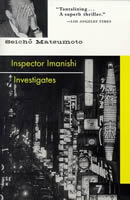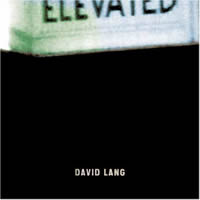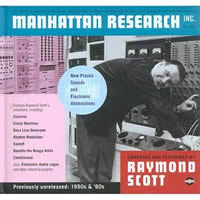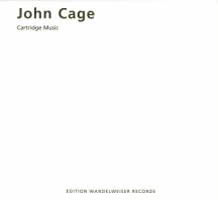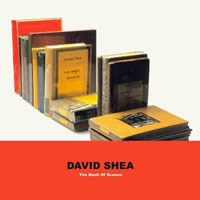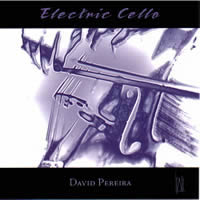EA Bucket 4.
|
Grant Chu Covell [February 2006.]
Inspector Imanishi Investigates by Seicho Matsumoto, trans. Beth Cary. Soho Press, Inc., 1989 (http://www.sohopress.com/). Of fictitious composers, Gustav Aschenbach may well be the most famous. There are others, of course, but can you name one who appears in a crime novel? (Atlas Shrugged does not count.) Eiryo Waga’s musique concrète plays an unsettling role in this page turner. I snagged the book because of its cover and postwar-Japanese setting, unaware that electronic music figures in the plot. Some might say Stockhausen got there first. I’ve already given away too much.
“Elevated.” David LANG: Wed (1995); How to Pray (2002); Men (2001). Lisa Moore (piano); Audrey Riley (cello, Hammond organ), Andrew Zolinsky (piano), James Woodrow (e-guit.), Nick Allum, Rob Allum (drums); Mike Svoboda (trombone), European Music Project, Jürgen Grözinger (dir.). Accompanying DVD contains films for each work: William Wegman: Treat Bottle (1972), Bill Morrison: How to Pray (2005) and Matt Mullican: Elevated (2005). Cantaloupe CA21029 (http://www.cantaloupemusic.com/). I enjoyed an earlier Cantaloupe release, Michael Gordon’s Decasia (see here), but Bill Morrison’s visuals soured the score. What had seemed well-defined became merely fortuitous. The slo-mo-decaying images strangled the music. Inasmuch as Cantaloupe pairs CD with DVD, it seems to me dishonest to consider the music separately from the b&w films. Wed’s 4:56 for solo piano is a gentle meander through differing chord patterns — light rain against a window. It demands hearing without the video of Wegman’s Treat Bottle wherein a dog noisily attempts to extract a biscuit from a milk bottle. The glass clanks loudly across the floor as the Weimaraner paws at it until the bottle breaks and the dog extricates the treat. I worried about the dog getting cut. Be that as it may, an incongruous coupling. It’s not clear what, if anything, Wed abbreviates. How to Pray and Men merely irritate. A gentle cello introduces the former, with drums and electric guitar uncoiling nimbly — disruptive busy-work heard from afar. Not much happens. The music begrudgingly alters its chords. Morrison’s grainy iceberg might be from the same damaged stock as Decasia. The gray ice suggests a Henry Moore nude, with any meaning expiring long before the conclusion of this 10:15 work. Dedicated to Lang’s teacher Henze, Men fares a little better. A solo trombone joins English horn, bass clarinet, baritone sax, keyboards, percussion and low string trio (viola, cello and double bass). The percussion includes a sound heard on Child, rather like a knitting needle skirting a brake drum (see here). The music’s spacious 43:28 time span works, even if it does sound rather like an inattentive Bruckner stalling at the third beat. I’m thinking the improvements over How to Pray’s instrumentation may merely be dumb luck. Mullican credits Elevated’s images to a 1935 16mm film by one D.G. Oswald. We see a vibrant New York City: traffic, crowds, lights, store windows, marquees, music hall shows, children playing, horses jumping, the elevated railway, Central Park, Coney Island, etc. Mullican segments the footage with continual blackouts. Priceless images withal for nostalgia buffs and historians. Lang’s music provides a suitably gloomy background. The pervasive sadness suggests imminent disaster. A vanished New York reminds one of rather more recent damage.
“Manhattan Research, Inc.” Music of Raymond SCOTT. Basta Music 90782 (http://www.bastamusic.com/). This not-new two-CD set arrived with a lavishly designed 144-page book packed with details. This collection contains Scott’s work from the ’50s and ’60s, including some of the bandleader’s commercials (Baltimore Gas & Electric Co., IBM, Hostess Twinkies, Vim, Sprite, Country Fair Bread, etc.), along with scores to several pre-Muppet Jim Henson shorts, assorted backgrounds, outtakes and “pure” compositions. Secretive Scott kept the inner workings of his electronic inventions to himself. Robert Moog supplied custom circuitry, never suspecting his role in the construction of Scott’s “Clavivox,” “Electronium,” or “Bandito the Bongo Artist.” Sticking to a 12-note-per-octave scale, the music employs clearcut beats and familiar chord progressions. One hears non-Western influences, minimalist hints, and some glittery pop excesses. Setting aside the nostalgia quotient, here’s a febrile imagination creating an oeuvre no one else has duplicated. How did I miss this compilation back in 2000? The folks at http://www.raymondscott.com/ promise a sequel with longer, more extended compositions. Until then, we’ve three volumes of Soothing Sounds for Baby.
John CAGE: Cartridge Music (1960). Daswirdas: Matthias Bruppacher, Kaspar Glättli, Nina Hitz, Boris Previsic, Christoph Reller, Peter Rüegg. Edition Wandelweiser Records EWR 0406 (http://www.wandelweiser.de/). Cartridge Music sprawls across one very entertaining hour. Cage’s basic premise was to amplify small sounds, such as could be inserted into a phonograph pickup. (For the discussion of another realization, see here.) The Daswirdas troupe rolls out short, variably dense and dynamic bursts, including the inevitable fingertip rubbing against a needle, ticking clocks, distorted radio noise, controlled feedback, and assorted clicks and pops. The always evident amplification is smoothly employed. This 2003 recording calls to mind the last century’s analog era. One hears slight repetitions, as if looped samples, physical recurrences, or a record’s stuck groove. You’ll probably look around the room to assure yourself that the sounds are emitting from your speakers. There were moments when ambient noises (a passing car, a noisy heating system) made me wonder. Cage would have gladly approved.
David SHEA: The Book of Scenes (2003-05). Vincent Royer (viola), Jean-Philippe Collard-Neven (piano), David Shea (sampler, electronics). Sub Rosa SR224 (http://www.subrosa.net/). I wish I had written this engaging, variably organized trio for viola, piano and electronics. In the credits, Shea thanks Luc Ferrari. The late master’s influence is certainly evident, especially in the panting Elegy. The Book of Scenes collects 29 mysterious trinkets. Some are solos; others, witty employments of pre-recorded sounds. At moments the piano is obviously prepared; at others, pianist and violist tap and bow the other’s instrument. The 50:24 series follows a happy logic, though in fact the movements can be reordered in live performance or at home by shuffling playback. The cheeky concrète bits within Radio Weekend juxtapose sensibly. The big band leaping out of Exotique feels right, as does that segment’s deterioration into cartoonish antics. It’s easy to forget that a viola and piano occupy stage-front. In Spaces, as an excellent example, the duo takes on a Webern-meets-Messiaen character. Like all the Sub Rosa releases I’ve heard, the sonics are fittingly full-throated.
“Electric Cello.” Var. composers. David Pereira (cello), Christo Curtis (eng.). Tall Poppies TP180 (http://www.tallpoppies.net/). Electronics notwithstanding, Pereira’s warm playing takes center stage. Via delays and tape, Pereira really gets cooking. Compared to more recent peers, the earliest work, Roger Smalley’s 1978 Echo II, for cello and two digital delays, holds up well. With the exception of a startling crackling (the cello being crushed or dragged over gravel?), Carl Vine’s 1994 Inner World mates Pereira with sampled cello sounds in a tone poem of undifferentiated tonalities. Despite an earnest attempt to bring the 1999 East Timor civil war to our attention, Martin Wesley-Smith’s computer-game-like Welcome to the Hotel Tourismo (2000) dribbles goofily. Andrew Ford’s Memorial (1994) and Nigel Westlake’s Onomatopoeia (1984) pair the instrument with digital delay. Memorial explores gritty textures and the instrument’s top range, Onomatopoeia utilizes repeated segments to create blankets. A mostly smart collection, expertly recorded.
[Previous Article:
You There! Yes, You! Why Are You an Audiophile?]
[Next Article:
’Philespeak]
|
